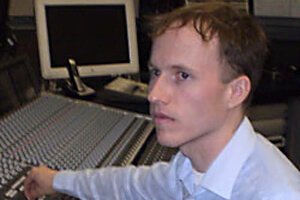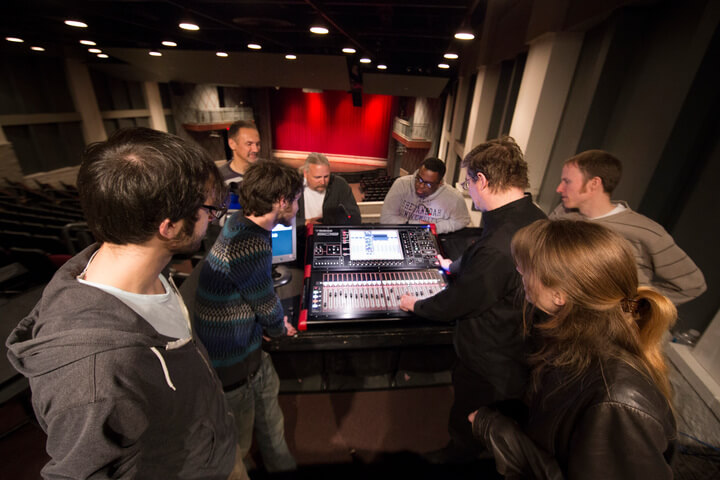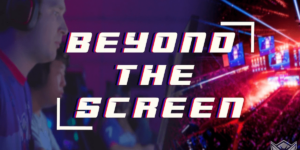The Recording Excellence blog wants to make it clear: Shenandoah Conservatory Assistant Professor of Music Production and Recording Technology Adam Olson, M.A. is one of the “15 Outstanding Professors Every Audio Enthusiast Should Know.”
“No matter if you’re interested in enrolling in one of the great programs these professors are a part of, or simply wanting to learn more about recording, being aware of the best and having something to strive for can be tremendously motivating,” writes Recording Excellence Founder/Editor Scott Hawksworth in his list introduction.
In a separate interview, he explained how he learned about Olson’s talents. “I actually don’t know Adam personally, but I discovered him when I was doing research for the article,” Hawksworth said. “I scoured the internet to find notable professors that I found inspirational and thought would also inspire my readers. Adam’s experience and contributions to the field really stood out to me. In addition to his general educational background and experience working in studios I was impressed by the fact that he has founded two studios, his paper contributions to the field, found via the Audio Engineering Society (here’s one paper, and another) and his certification as an instructor for both Pro Tools and Logic Pro and his expertise in DAWs, which have revolutionized recording.”
Pretty great stuff, eh? So what does Adam think about making the list? We asked him that and a few other questions to help you get to know this audio pro.
How did you find out you were on the list, and how did you feel when you saw it?
 Adam Olson: Every other year the Audio Engineering Society (AES) convention is held in New York City and Director and Associate Professor of Music Production and Recording Technology Golder O’Neill [M.M.E.] and I take our students. While there, Matthew Boerum who used to teach at American University, initially informed me about it. I didn’t think he was being serious and thought he was joking around as dudes do. Matt told me that he saw me on the top 10, then when he found the page he said “Oh top 15 – so don’t let it go to your head.” When he showed me the actual posting I was surprised to see the listing, since it is a website I am actually familiar with in the industry; I have no affiliation with it of course. Another engineer I caught up with at the convention, whom I met while working at QUAD Studios in NYC, also told me about it and joked about getting my autograph.
Adam Olson: Every other year the Audio Engineering Society (AES) convention is held in New York City and Director and Associate Professor of Music Production and Recording Technology Golder O’Neill [M.M.E.] and I take our students. While there, Matthew Boerum who used to teach at American University, initially informed me about it. I didn’t think he was being serious and thought he was joking around as dudes do. Matt told me that he saw me on the top 10, then when he found the page he said “Oh top 15 – so don’t let it go to your head.” When he showed me the actual posting I was surprised to see the listing, since it is a website I am actually familiar with in the industry; I have no affiliation with it of course. Another engineer I caught up with at the convention, whom I met while working at QUAD Studios in NYC, also told me about it and joked about getting my autograph.
What drew you to audio engineering?
A.O.: About fifteen or so years ago I was a jazz and classical major teaching an undergraduate course in guitar at Brigham Young University. After 12+ hours of daily practice during the summer of 1999, I injured my hands from overuse. I knew I could never leave music because practically nothing got me out of bed but that. I was planning on being a studio musician at the time, so I figured while my hands were healing I might as well learn “the other side of the glass” and began taking audio classes. My hands never completely healed, and here I am.
After working commercially, what prompted you to teach?
I started teaching guitar around the age of 16 and really enjoyed it; I found it helped me to become a better player and pushed me in ways that just practicing on my own didn’t. That’s what inspired my plan to teach and play guitar.
Who are some professors and fellow engineers who influenced you?
A.O.: Mickey Houlihan of CurveBlue – who, in particular, is an excellent person all-around and producer. He takes his time with what he does and makes sure he has a great love and passion for what he puts his time into.
Steve Wiest at Studio Stars also was a big help in my understanding that you not only need to stay focused and work quickly with talent even when they are goofing off, but also take your time with things that need more attention and care.
What do you enjoy most about your work?
A.O.: There are really three things that stand out to me:
1.) I really enjoy when students who have worked on audio projects and had real-world struggles learn a better way to operate in class, leading to a “I wish I had known” moment that helps not only the student, but also the entire class.
2.) Though not part of my job description at Shenandoah University, but certainly directly linked to it, I very much enjoy collaborative songwriting and producing. It allows more of the creative choices and ideas to flow rather than an “in and out” recording session where budgets often appear to be the highest concern.
3.) I also very much enjoy AppleScripting and creating shortcuts and workflows that speed up repetitive tasks on the computer. I often catch myself smiling while creating such macros, scripts and applications. I have several hundred that I use, but one I decided to make to make public is called SP Resize – it helps manage windows on single or dual screens. It’s also helpful for web development to have your browser change to another screen resolution and see how it would look on say a laptop if viewing on a larger screen.
What makes Shenandoah’s MPRT program special?
A.O.: This is an easy one. I feel Shenandoah University sets itself apart from other programs in that this is a music degree first. Students gain musical knowledge while at Shenandoah Conservatory and must come in with a certain level of musical ability, first and foremost, beyond any technical ability. To top that off, we offer more audio recording classes in a music degree (and in many cases, than a Bachelor of Science at most schools) than any school that I am aware of in the country thanks to the leadership of Golder O’Neill. We particularly focus on music and recording (rather than game audio or sound for film, though we offer courses in both) which we feel empowers our students to be better engineers, and producers, should they choose.
Want to find out more about Adam’s world and what Music Production & Recording Technology is all about?





